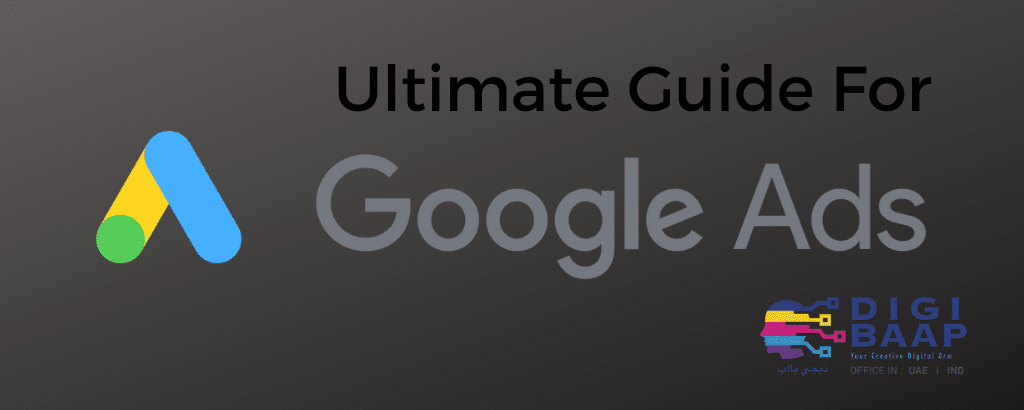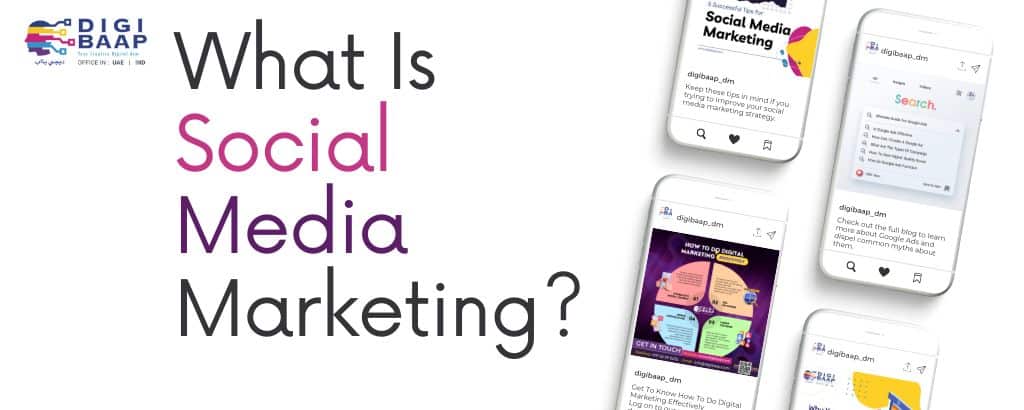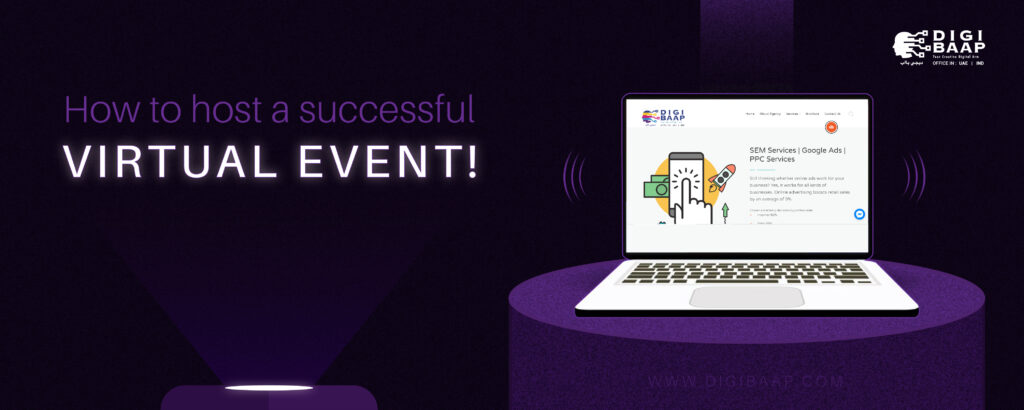You’d better spend your money wisely if you’re thinking of using advertisements to reach your target market.
That is, a place that receives more than 2.9 billion unique visitors each month and 5 billion daily interactions.
That is Google.
It’s no secret that these days, the more effective and targeted your paid ads are, the more clicks they produce and the higher the likelihood that they will bring in new clients.
So it should come as no surprise that businesses across all sectors are using Google Ads more and more frequently.
You’ll learn how to start advertising on Google in this guide. We’ll go through platform-specific features and show you how to fine-tune your campaigns for the greatest possible ad outcomes.
Explain Google Ads.
Google Ads is a platform for paid advertising that operates under the pay-per-click (PPC) marketing model, in which you, the advertiser, pay per click or impression (CPM) on an ad.
Google Ads are a successful technique to attract qualified visitors, or good-fit clients, to your company who are looking for the goods and services you provide. You may improve in-store traffic, increase phone calls to your business, and increase internet traffic using Google Ads.
With Google Ads, you can make and distribute strategic advertisements to your target market on desktop and mobile devices. As a result, when your target clients use Google Search or Google Maps to look for goods and services similar to yours, your company will appear on the search engine results page (SERP).
By doing this, you can reach your target market at the right time for them to see your advertisement.
Notably, platform advertisements may also appear on YouTube, Blogger, and the Google Display Network.
In order for your company to achieve all of your paid campaign objectives, Google Ads will eventually assist you in analyzing and improving those advertisements to reach more individuals.
You can also modify your advertisements to fit your budget regardless of the size of your company or the resources you have at your disposal. You can keep under your monthly budget with the help of the Google Ads tool, and you may even suspend or discontinue your ad spending at any moment.
Moving on to a more pressing concern, are Google Ads actually effective? Let’s look at some facts to help us respond to this:
- The click-through rate for Google Ads is over 2%.
- 180 million impressions from display advertising are generated per month.
- Paid advertisements on Google receive 65% of clicks from individuals who are prepared to make a purchase.
- 43% of buyers make a purchase after seeing an advertisement on YouTube.
Are Google Ads effective?
Google Ads do indeed work. With an optimized ad campaign and lead flow, you may construct a marketing campaign with a high return on investment.
Why should I run a Google ad?
With more than 5 billion searches performed each day, Google is the most popular search engine. Furthermore, the Google Ads platform has been in existence for about 20 years, providing it some experience and legitimacy in sponsored advertising.
People all over the world use Google as a resource to ask questions that are then answered by a combination of paid adverts and organic results.
Do you need one more? Your rivals are utilizing Google Ads (and they might even be bidding on your branded terms).
Because so many businesses use Google Ads to market their brands, even if you’re ranking organically for a certain search keyword, your results will be pushed down the page under those of your rivals.
There is no way around using Google Ads if you’re using PPC to advertise your goods or services (the only exception might be Facebook Ads, but that’s another issue).
Guidelines for Google Ads
If you’ve tried Google advertising but had little success, don’t give up. For a number of reasons, your Google Ads might not be performing as they should. But first, let’s review some typical Google Ads best practices.
1. For PPC planning, use a template.
Using a planner can help you maintain organization in your PPC efforts. With the Google PPC Planner Template, you can manage all of your campaigns, verify the text counts for your adverts, and see how they will appear online.
2. Don’t use broad-based keywords.
You should test and refine your plan because you need to be perfect for your keywords. If your keywords are too general, your ad will be displayed to the incorrect audience, resulting in fewer hits and a higher ad cost.
Examine what is effective (i.e., the keywords that receive clicks) and alter your ads as necessary to make them more pertinent to your target audience. It’s likely that the initial mix won’t be ideal, but you should keep adding, removing, and changing keywords until it is.
3. Run no-brainer advertisements.
You won’t obtain enough clicks if your ad doesn’t correspond to the searcher’s intent to make your ad spend worthwhile. The keywords you are bidding on must be reflected in your headline and ad copy, and the product you are promoting in your ad must address any problems the searcher may be having.
It’s a combination that will provide the outcomes you want, and it could only require a few adjustments. With the option to generate many ads per campaign, you may test different versions to see which performs best. Use Google’s Responsive Search Ads option instead, or even better.
4. Gain a higher Quality Score (QS).
Google uses your Quality Score (QS) to decide where to place your ad.
Your rank and positions on the Search Engine Results Page will improve with a higher QS (SERP). Less people will see your advertisement and you will have fewer opportunities to convert if your quality score is low.
Although Google informs you of your Quality Score, it is up to you to raise it.
5. Enhance your ad’ landing pages.
Your efforts shouldn’t stop with your ad; the experience a consumer has after clicking is as crucial.
What does a user see after clicking your advertisement? Is your landing page’s conversion rate optimized? Does the page answer your user’s question or solve their issue? Your user has to be able to proceed through the conversion process with ease.
Know the Terms for Google Ads
- AdRank
- Bidding
- Campaign Type
- Click-Through Rate
- Conversion Rate
- Display Network
- Ad Extensions
- Keywords
- PPC
- Quality Score
You can set, monitor, and improve your Google Adwords with the aid of these frequent phrases. While some of these are specifically tied to Google Ads, others are more broadly PPC-related. In either case, you must be aware of these to manage an efficient advertising strategy.
1. AdRank
Your ad placement is determined by your AdRank. The greater the worth, the better you’ll rank, the more people will see your ad, and the more likely it is that they will click it. Your max bid multiplied by your Quality Score yields your AdRank.
2. Bidding
You, the advertiser, choose a maximum bid amount you’re ready to spend for a click on your ad in the Google Ads bidding system. The better your placement, the greater your bid should be. CPC, CPM, or CPE are your three possibilities when placing a bid.
- CPC, or cost-per-click, is the amount you pay for each click on your ad.
- CPM, or cost per mille, is the amount you pay for one thousand ad impressions; that is when your ad is shown to a thousand people.
- CPE, or cost per engagement, is the amount you pay when someone takes a predetermined action with your ad.
3. Type of Campaign
You have seven campaign kinds to choose from on Google Ads before you start a sponsored campaign: search, display, video, shopping, app, smart, or performance max.
- Search ads are text ads that are displayed among search results on a Google results page.
- Display ads are typically image-based and are shown on web pages within the Google Display Network.
- Video ads are between six and 15 seconds and appear on YouTube.
- Shopping campaigns appear on search results and the Google shopping tab.
- App campaigns use information from your app to optimize ads across websites.
- Smart campaigns have Google finding the best targeting to get you the most bang for your buck.
- Performance Max is a new campaign type that lets advertisers access all Google Ads inventory from a single campaign.
4. Click-Through Rate (CTR)
The CTR is the ratio of the amount of clicks you receive to the amount of views for your advertisement. A higher CTR implies a high-quality ad that targets pertinent keywords and matches search intent.
5. Conversion Rate (CVR)
Forms submits as a percentage of all landing page views are measured by CVR. Briefly place, a high CVR indicates that your landing page offers a seamless experience for users that fulfills the promise of the advertisement.
6. Display Network
Google advertising can appear on a webpage within Google’s Display Network or the search results page (GDN). GDN is a group of websites that give Google Adverts space on their web pages. These text- or image-based ads are shown next to material that is pertinent to your keyword phrases. Google Shopping and app campaigns are the most often used Display Ad choices.
7. Extensions
With the aid of ad extensions, you may add free-of-charge information to your advertisement. Sitelink, Call, Location, Offer, or App are the five categories under which these extensions can be divided.
8. Keywords
Google provides a selection of results that correspond to a searcher’s query when they enter it into the search field. Keywords are phrases or words that describe what a searcher is looking for and will answer their question. The searches you want your ad to appear alongside influence the keywords you choose. A searcher who puts in “how to wipe gum off shoes” will, for instance, see results for marketers who have chosen to target terms like “gum on shoes” and “clean shoes.”
Lists of keywords that you do not want to rank for are known as negative keywords. You will be removed from the bidding on these keywords by Google. These are usually vaguely connected to the search terms you were going for but are unrelated to the services you provide or the keywords you would like to rank for.
9. PPC
Pay-per-click advertising, also known as PPC, involves the advertiser paying for each click on an advertisement. Although PPC is not exclusive to Google Ads, it is the most typical kind of paid campaign. Before starting your first Google Ads campaign, it’s critical to comprehend all aspects of PPC.
10. Quality Score (QS)
Your Quality Score gauges the effectiveness of your ad based on factors like click-through rate (CTR), keyword relevance, landing page quality, and prior SERP performance. Your AdRank is based in part on QS.
How do Google Ads function?
Potential leads or clients who are looking for your product or service are shown your ad through Google Ads. Depending on the sort of ad campaign chosen, advertisers bid on search phrases, or keywords, and the winners of that bid are displayed at the top of search results pages, on YouTube videos, or on relevant websites.
Your capacity to develop successful and high-performing Google Ads is impacted by a variety of things. They will be discussed here, along with several Google Ads samples.
AdRank and Quality Score
Your advertising’ placement is determined by AdRank, and one of the two factors—the other being bid amount—that affects your AdRank is Quality Score. Keep in mind that your Quality Score is based on the caliber and relevancy of your advertisement, and Google gauges this by the number of people that click on your advertisement when it is displayed, or CTR. Your ad’s ability to successfully match searcher intent will determine how well it performs on click-through rates (CTR).
- How relevant your keywords are
- If the searcher receives the results they expect from your ad copy and CTA
- The landing page’s user experience even before you raise your bid amount, you should pay close attention to your QS when you first set up your Google Ad campaign. Your acquisition fees will be reduced and you’ll be placed higher with a higher QS.
Location
You choose the region where your Google Ad will be displayed when you first put it up. If you have a storefront, it should be quite close to where you are physically located. If you run an online store and sell actual goods, you should specify your location to the locations from which you ship. The possibilities are endless if you offer a service or good that is available to everyone in the world.
Your location settings will affect how you are placed. For instance, even if your AdRank is high, if you run a yoga studio in San Francisco, someone searching for “yoga studio” in New York won’t see your result. That’s because Google’s main goal is to show users the best relevant results, even if you’re paying for it.
Keywords
Both paid advertisements and organic search benefit from keyword research. Your keywords should as closely as possible reflect the objective of the searcher. This is due to Google matching your advertisement with searches based on the keywords you chose.
One to five keywords are ideal for each ad group you designate inside your campaign, and Google will display your ad in accordance with those choices.
Match Types
Match Types provide you some leeway when it comes to choosing your keywords because they inform Google whether you want to match a search query precisely or if you want your ad to be displayed to everyone who enters a semi-related search query. There are four different match types available:
- The default mode, known as Broad Match, uses any word inside your keyword phrase, in any sequence. For instance, “goat yoga in Oakland” or “yoga Oakland” will match.
- Modified By designating specific terms within a keyword phrase with a “+” sign, Broad Match enables you to lock in those words. Your matches will at the very least contain that locked-in term. For instance, searching for “+goats yoga in Oakland” can get results for “goats,” “goats like food,” or “goats with yoga.” This is Modified Broad Match
- Phrase Match will correlate with queries that contain your keyword phrase in the exact order, even if they contain other terms either before or after it. Goat yoga, for instance, can also refer to “spotted goat yoga” or “goat yoga with pups.”
- Exact Match keeps your keyword phrase in the exact order that it is written. If someone types “goats yoga” or “goat yoga class,” for instance, “goat yoga” won’t appear.
Switch from a broad match to a more specific approach if you’re just getting started and are unsure of how your persona will be searching so you can test which questions get the greatest results. However, because your ad will appear for a variety of queries, some of which are irrelevant, you should monitor your advertising carefully and make any necessary adjustments as you learn more.
Headline and Description
Your ad copy may determine whether someone clicks on your ad or one from a rival. As a result, it’s crucial that your ad language aligns with your target keywords, satisfies the persona’s pain point, and matches the searcher’s intent. Let’s look at an example to see what we mean.

This came up in a search for “infant swim instruction.” The material is succinct and makes effective use of the available space to communicate its point and engage its intended audience.
Because The Swim Revolution used the phrase in their headline, we can immediately tell that the ad is relevant to our search. The description also explains why this is the ideal choice for swim lessons by addressing the issues that their persona, a parent trying to enroll their child in a swim class, would have.
They allay our fears of placing a baby in the water by using phrases like “skills,” “fun,” “confidence,” and “comfort in the water,” and they show us that we will obtain the result we desire from this class: a baby who can swim.
Clicks will be generated by this type of advertisement, but conversions will come from incorporating this degree of intent into your webpage content.
Ad Extensions
Ad Extensions should be used if you are running Google Ads for two reasons: they are free, and they give users more information and another motivation to interact with your advertisement. These extensions fall under one of the following five groups:
• Sitelink Extensions give users more compelling reasons to click on your site by extending your advertisement, which makes it stand out.

• Call Extensions let you add your phone number to your advertisement so that users have another (immediate) means to contact you. Include your phone number if you have a team of customer care representatives prepared to interact with and persuade your audience.

Location Extensions include your location and phone number within your ad so Google can offer searchers a map to find you easily. This option is great for businesses with a storefront, and it works well for the search query “…near me.”

Offer Extensions work if you’re running a current promotion. It can entice users to click your ad over others if they see that your options are discounted compared to your competitors.

App Extensions provide a link to an app download for mobile users. This reduces the friction of performing a new search to find and download the app in an AppStore.
Google Ads Retargeting
Retargeting, also known as remarketing, is a strategy used in Google Ads to promote to consumers who have previously interacted with you online but have not yet purchased. Users who are tracked by cookies will see your advertising as they browse the web. Remarketing works well because most potential customers need to see your advertising repeatedly before becoming clients.
Types of Google Ads Campaigns
- Search
- Display
- Video
- App
- Shopping
On Google Ads, you may choose from one of five different campaign kinds. Let’s discuss the best applications for each and the reasons why you would favor one over the other.
1. Search Ad Campaigns
Text advertisements known as search adverts are seen on Google results pages. For instance, a search for “Mobile” yields the following sponsored results:
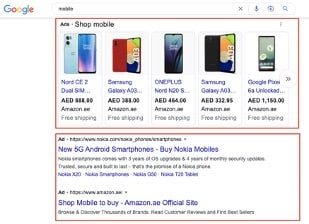
The advantage of search advertisements is that they allow you to publish your advertisement on Google, which is where most people turn to first when searching for information. Users are accustomed to viewing and clicking on results since Google displays your advertisement in the same way as other results (apart from designating it as a “Ad”).
Responsive Search Ads
When you utilize responsive search advertising, Google will choose the top-performing headlines and ad copy (15 and four variations, respectively) to show to users. When creating a static version of a standard advertisement, you always use the same headline and description.
With responsive advertisements, you can create dynamic ads that are automatically tested until you find the one that works best for your target demographic — or, in Google’s case, until you get the most clicks.
2. Display Ad Campaigns
The Google Display Network is a collection of websites owned by Google that accept Google Ads and are in a variety of markets. The fact that the website owner is compensated for each click or impression on the adverts is advantageous. The advantage for advertisers is that they can expose their content to persona-relevant audiences.
These are frequently graphic advertising that divert readers’ attention from the webpage’s content:


3. Video Ad Campaigns
Keep in mind that YouTube is a search engine as well. Therefore, using the appropriate keywords will bring up a movie and briefly stop the user’s current course of action in order to get their attention.
The following video appears in the middle of another instructional film.
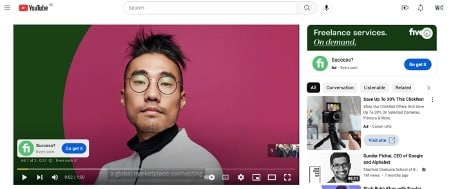
4. App Ad Campaigns
Through an advertisement that appears on Google Search Network, YouTube, Google Play, Google Display Network, and other sites, Google App Campaigns advertise your mobile application.
You can run advertisements urging people to download your app or, if they already have it, to perform a specific action inside of it.
Unlike other ad formats, an App ad campaign is not something you create. Instead, tell Google about your app’s features and target market before making a bid. Google takes care of the rest to expose your app to the appropriate users
How to Use Google Ads
Have we persuaded you to start utilizing Google Ads? Good. Starting is easy, but there are a few stages involved. Here is a step-by-step tutorial for creating your first Google Ads campaign.
1. Set up your Google Ads account.
Visit the Google Ads homepage first. Click “Start Now” in the top right corner of the screen.

You will be asked to sign in using an existing Google account or create a new one.
2. Select a name for your company and a website.
You will be directed to a screen after logging in where you must enter the name of your company and its website. Anyone who clicks on your advertisement will be directed to the URL you provide.


3. Choose your advertising objective.
Choose your primary advertising objective next. You have four options: increase phone calls, website purchases or sign-ups, foot traffic to your storefront, and YouTube views and engagement.

4. Create a compelling advertisement.
Your ad needs to be created next. This can be a little difficult and calls for inventiveness.
Thankfully, Google provides writing suggestions. Of course, writing an advertisement that will draw in and influence your audience is the most crucial step.
5. Include Keyword Themes
You can select keywords that go with your brand on the following page. If you’re unfamiliar with keyword research, Google will offer a few for you; we advise starting with those suggestions. Click “Next” once the appropriate keywords have been chosen.
6. Choose the location for your advertisement.
You can select the location or sites on which you want your advertisement to appear on the following page. It can be far from your home address or somewhere else entirely.
7. Decide on a budget.
Here, you can either specify a specific budget or choose from Google’s budget possibilities.
8. Verify the payment.
Give your billing details last.
And just like that, you’ve made your first Google ad!
As you can see, creating your sponsored ads on Google is rather simple (and quick), largely because the platform guides you through the process and offers useful tips along the way. The setup should only take you ten minutes if you already have your ad wording and/or images ready.
Less evident are all the extra steps you must take to make sure your advertising are well-positioned and straightforward to track. Let’s discuss these as a group. These are the actions you should do after submitting your advertising for approval.
9. Connect your Google Analytics profile.
If Google Analytics isn’t already installed on your website, here’s how to install it on WordPress so you can measure visitors, conversions, objectives, and any other special data. Additionally, you must connect your Analytics account to Google Ads. Because you can monitor these occurrences in one location, linking these accounts will make tracking, analyzing, and reporting between channels and campaigns much simpler.
10. Start tracking conversions.
How many clients or leads you actually received as a result of your advertising campaigns is revealed by conversion tracking. Although setting it up is optional, doing so will force you to estimate the ROI of your advertising. You can monitor purchases (or other actions) made through your website, app downloads, or phone calls generated by your adverts using conversion tracking.
11. Connect your CRM to your Google Ads.
Keeping all of your data in one location where you can track, examine, and report on it has some merit. You already track contact information and lead flows in your CRM. To continue promoting to your audience with offers that are relevant to them, you may track which ad campaigns are effective for them by integrating Google Ads with your CRM.
Strategies for Bidding on Google Ads
It’s time to start bidding once your ad campaigns are set up and tracking is established. Keep in mind that your potential to rank in Google Ads depends on your bid strategy. When starting your paid campaign, there are a few methods and bid settings you should be aware of even though your bid amount will rely on your budget and objectives.
Manual vs. Automated Bidding
When it comes to bidding on your keywords, you have two choices: automated and manual. Here is how they function:
- Automated Bidding gives Google control and enables the platform to modify your bid in response to rivals. You can still select a maximum spending limit, and Google will work within that range to offer you the best opportunity to place the winning bid.
- By using Manual Bidding, you can control the bid levels for your ad groups and keywords, which gives you the opportunity to spend less on advertisements that aren’t performing well.
Bidding on Branded Search Terms
Branded terms include the name of your business or a distinctive product, such as “Digital Marketing Agency.” Whether or not to bid on your brand phrases is a topic of significant discussion. On one side of the argument, placing a bid on terms that are likely to produce organic results can be seen of as money wasted.
The other justification for bidding on your branded phrases is that if you don’t, your rivals might, so occupying valuable space that ought to be yours.
Cost Per Acquisition (CPA) You can set a CPA instead and only pay when a user converts into a customer if the thought of paying money to convert prospects into leads unnerves you. Even while this bidding technique could be more expensive, you can rest easy knowing that you only pay when you acquire a paying customer. This tactic makes tracking and defending your advertising expenditure simple.
Get your Google Ads campaign going.
Given its power and reach, Google Ads ought to be a component of your paid campaign. Use the advice we provided to get going, and keep in mind to tweak and improve as you go. There are just campaigns that require a little bit more work; there are no Google Ads campaigns that don’t work. You have everything you need to construct an effective Google Ad campaign that generates clicks and leads by using the above strategy and information.

